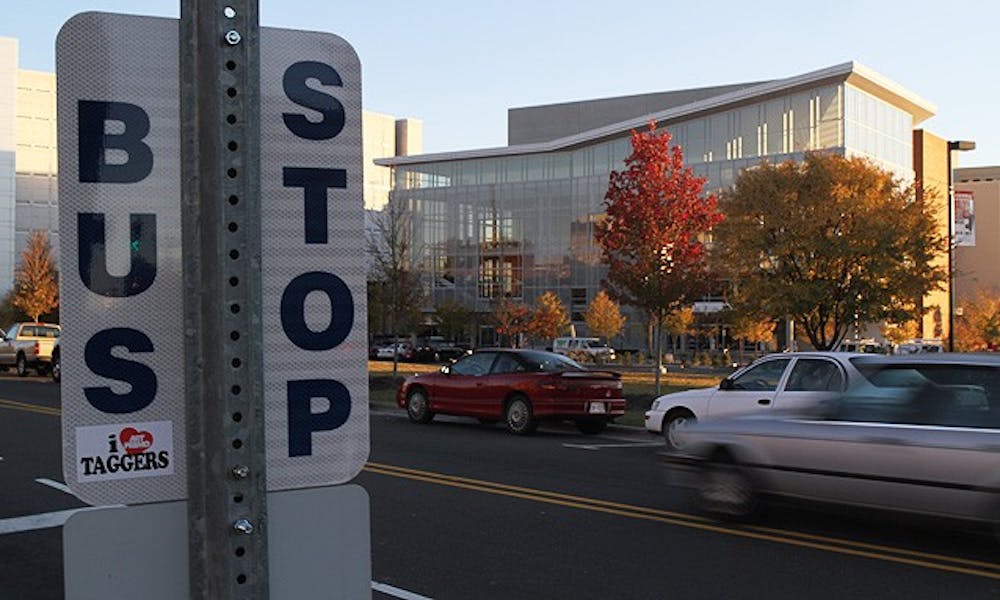Three months into operation, the Bull City Connector has increased traffic between Duke and the Durham art scene, but there is still room for improvement.
The BCC, which started Aug. 16 through a collaboration between Duke and the city of Durham, is a free, publicly accessible bus system that includes stops at the Duke Medical Center, downtown Durham, the American Tobacco District and the Golden Belt arts complex.
The bus system and the new routes it has created have significantly improved the visibility of the arts scene downtown, said Downtown Durham Inc. President Bill Kalkhof.
“[Since Downtown Durham Inc.’s founding in 1993,] we have and are continuing to build an environment with restaurants and theaters and ball parks that would be of interest to people,” he said. “Now, we have way more students coming downtown than we used to because we’re creating an environment that they want to come to.”
Approximately 1,300 students, employees and Durham residents ride the bus per day, and ridership has been increasing steadily since August, said Sam Veraldi, director of Duke Parking and Transportation Services. He added that their goal is to reach 2,000 riders per day by August 2011.
“Generally speaking, everyone’s pretty happy with where we are at this point,” Veraldi said. “I do believe the buses have made a difference [in engaging students with the arts in Durham]. I like that we have provided another option for students to ride out into the city.”
Gary Kueber, chief operating officer of real estate development company Scientific Properties, which developed Golden Belt, said the BCC has generated more traffic to the complex.
“We have definitely seen an impact and increased activity,” Kueber said. “We have had a lot of people in good attendance and using the BCC for Third Friday, [a monthly, open studio event for artists and visitors].”
Duke and Durham currently have no means to distinguish between the various groups that use the bus system. Veraldi estimated that of the Duke riders, about 70 percent are employees and 30 percent are students. Although this breakdown is “expected,” he said he would like to see more students utilizing the buses.
A key advantage to the BCC is its benefits for employees, including easier and faster commutes, Kalkhof said. He explained that this effect then stimulates the local economy.
“One of the disadvantages of working downtown was driving and parking, but now we started successfully recruiting a number of Duke employees downtown,” Kalkhof said. He added that about 3,000 Duke workers currently commute into the city.
Even so, the BCC is still underutilized, Kueber said.
“I would love to see more students take advantage of it and use it to come to events and art happenings downtown,” he said.
The marginal ridership may result from the hectic schedule of the average Duke student, said sophomore Chris Brown, Duke Student Government vice president for athletics and campus services.
“Students are just going, going, going all the time and are not, necessarily, using all their free time to go out and explore [Durham],” Brown said. “Since the BCC is about three months old, I don’t think a lot of students have found the chance or the reason to budget the BCC into their fast-paced daily routine.”
To increase ridership among students, Brown said Parking and Transportation may reevaluate the BCC bus stops at Duke, which are currently located at Flowers Drive, Trent Drive and Erwin Road, to make them more convenient for students.
Parking and Transportation is also considering offering incentive packages for events and performances downtown and extending the operating hours of the BCC, Veraldi said.
“The whole notion of us trying to link the Bull City Connector to the Duke student base will be a focus area for next semester,” he said. Numbers about riding trends should be available in 2011.
He added that the main problem is the lack of knowledge and awareness of the BCC.
“I don’t think students understand how close the Flowers bus stop is to the West Campus bus stop,” Veraldi said. “If they did, that would increase usage even more.”
Even if students are better informed, there is the possibility they still might not use the services.
“Awareness isn’t where we’d like it to be, but whether or not students will take advantage when awareness is high—I don’t know,” Brown said.
The BCC provides the means and Durham provides the entertainment, but many students still hesitate to venture off campus. A culture shift and a different mindset, Kueber said, are necessary to motivate students to make the trek downtown—and that might take time.
“We’ve got an ingrained culture of driving or staying in a single neighborhood,” he said. “It’s going to take a while for people to fully think about [using the BCC] as the backbone for their night out.”
Get The Chronicle straight to your inbox
Signup for our weekly newsletter. Cancel at any time.

